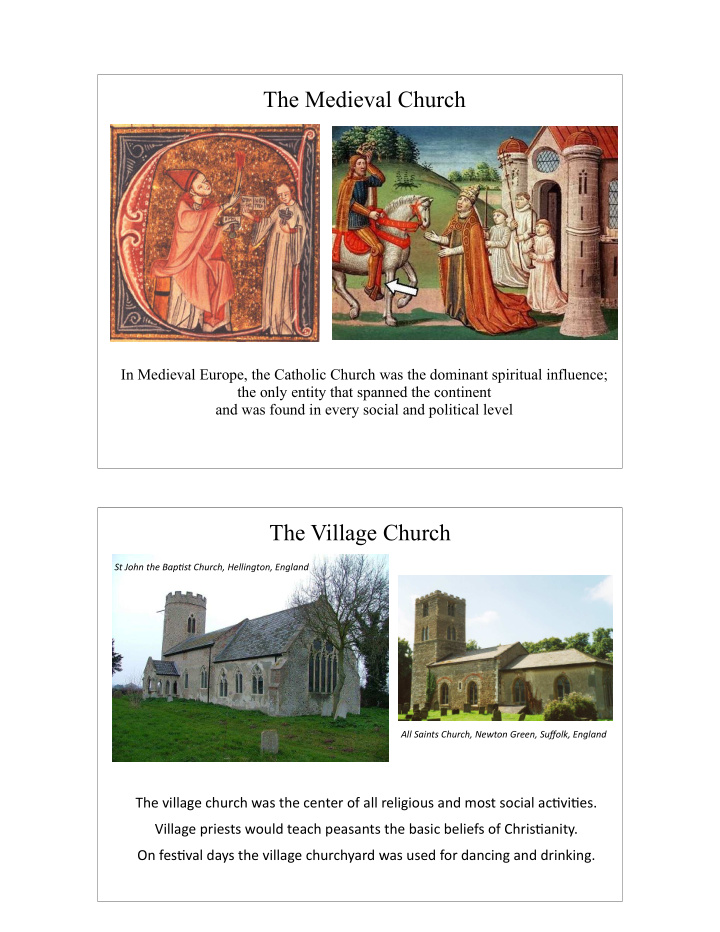



The Medieval Church In Medieval Europe, the Catholic Church was the dominant spiritual influence; the only entity that spanned the continent and was found in every social and political level The Village Church St ¡John ¡the ¡Bap,st ¡Church, ¡Hellington, ¡England All ¡Saints ¡Church, ¡Newton ¡Green, ¡Suffolk, ¡England The ¡village ¡church ¡was ¡the ¡center ¡of ¡all ¡religious ¡and ¡most ¡social ¡ac5vi5es. ¡ � Village ¡priests ¡would ¡teach ¡peasants ¡the ¡basic ¡beliefs ¡of ¡Chris5anity. ¡ � On ¡fes5val ¡days ¡the ¡village ¡churchyard ¡was ¡used ¡for ¡dancing ¡and ¡drinking.
Hierarchy of the Catholic Church parish priest � lowest rank � responsible for the religious instruction of his community � was part of the secular clergy [religious leaders who lived “in the world”] bishop � managed a group of parishes called a diocese � many were feudal lords or vassals in their own right � archbishop � managed several dioceses Hierarchy of the Catholic Church con’t cardinal � a member of the curia , the highest rank of clergy � advised the pope on legal and spiritual matters pope � supreme authority of the church � elected by a gathering of cardinals
Practicing Religion in the Medieval Period � The Sacraments to receive God’s grace one must take part in the seven sacraments (church rituals) Baptism Penance and done at birth to Reconciliation cleanse original sin an attempt to remove sin from the soul before death Confirmation the education of children in the Eucharist ways of the church the taking of Communion Anointing of Holy Orders Matrimony the sick when men and women joined the church. marriage Practicing Religion in the Medieval Period � Veneration of Saints The Virgin Mary The mother of Jesus St. Nicholas the most popular and The Patron Saint of Children most highly regarded of the saints Saints men and women who were considered especially holy and had earned a special place in Heaven
Practicing Religion in the Medieval Period � Relics Relics were objects connected with saints. � It was believed they could produce miracles. � Many people would make pilgrimages to visit relics. Set in an ornate reliquary in the Basilica San Domenico in Siena, Italy is the dismembered, mummified head of the revered Saint Catherine of Siena (1347-1380). � Reliquary Casket with Scenes from Her right thumb also resides in a the Martyrdom of Saint Thomas Becket, ca. 1173–80 smaller reliquary. Powers of the Church A practice known as simony developed where lords would sell church offices. � When an Abbot or Bishop was appointed to the church they were given a ring and a staff which symbolized the spiritual authority which was being invested in them by the church. Political rulers began to appoint church leaders (bishops, priests, etc.) in a practice known as lay investiture . � The church could excommunicate individuals, or deny them the ability to receive the sacraments. � The church could also place an interdict over an entire country. All churches would be closed and clergy would be forbidden to perform marriages, burials, other sacraments.
Pope Gregory VII 1073-1085 Pope Gregory VII wanted to end the practice of lay investiture. These actions became known as the Gregorian reforms. This led to a conflict with Holy Roman Emperor Henry IV who wanted to retain the right to appoint clergy. � “I, Henry, king by the grace of God, with all of my Bishops, say to you, come down, come down, and be damned throughout the ages.” � Pope Gregory excommunicated Henry and supported his overthrow. Henry IV traveled to Canossa in northern Italy to meet the pope and apologize in person. � Pope Gregory accepted Henry’s penance and lifted his excommunication. The Concordat of Worms 1122 Henry eventually overthrew the Pope and Gregory died in exile. � The conflict continued for several generations. � Finally in 1122 an agreement was made. � The Church won the sole power to appoint church officials. � The Holy Roman Emperor was allowed to give new bishops the symbol of government authority, the lance, while the church instilled the symbols of spiritual authority, the ring and staff.
New Religious Orders From the mid 11th century to the mid 12th century a wave of religious enthusiasm swept through Europe. More women began to began to seek spiritual involvement and joined convents The church was one of the few areas where women could get an education. Convents also became popular places for women who were unable or unwilling to marry. New Religious Orders The Cistercians This increase in religious activity led to the formation of several new monastic groups. � This Cistercian order were very strict, ate a simple diet, and owned only a single robe. � They removed all decorations from their churches and buildings and split their time between prayer and manual labor. � They weren’t allowed to speak unless absolutely necessary. This order developed a new spiritual model and strove to withdraw from the outside world.
New Religious Orders The Franciscans The Franciscan order was founded by Francis of Assisi. � The son of a wealthy merchant, he lived a bit of a wild youth and had a religious conversion in his early 20s. � Francis gave up all of his material possessions and began to teach to the poor. The Franciscan order tried to live as Christ had lived. The followers of the order believed in a vow of absolute poverty. � St. Francis also taught that there was beauty and holiness in nature. � The Franciscans took an active role aiding the poor. New Religious Orders The Dominican Order The Dominican Order was founded by a Spanish priest named Dominic de Guzman who, like the Franciscans, believed in a vow of poverty. � He saw the true mission of his order as one to end heresy , or beliefs that went against the Catholic Church. The Dominicans believed they were watchdogs of the Catholic faith.
Recommend
More recommend